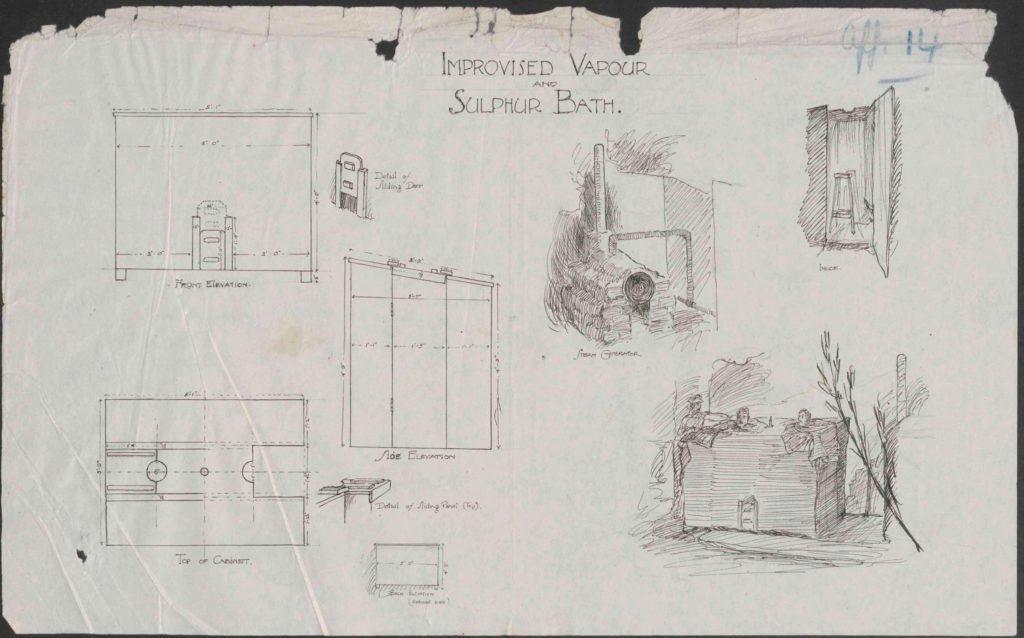Wednesday October 23rd, 1918
Nothing doing for me. Feeling a little better.
Medical Care
Frank will have reported to the Medical Officer again and has been signed off sick. The Medical Officer had a broad remit within the Battalion – responsible for not only the well-being of the troops but also for the sanitation and hygiene of the camps.
Some ailments could be treated within the Battalion. For others, the patients had to be sent further down the line. An example of this is scabies, which could run rife if untreated.
Scabies is a contagious skin condition caused by tiny mites which burrow into the skin. In WWI it was the most common skin infection faced by the troops and interestingly, remains a threat to troops in the 21st century.
Simple cases could be cured after three or four days treatment. However, given the conditions in WWI, it wasn’t unusual for complications to occur, in which case a soldier could spend many weeks in hospital. Consequently it was important to treat outbreaks quickly and effectively.º
Treatment of Scabies
The 1/2nd East Lancs Field Ambulance had to handle such an outbreak in spring/summer 1917.
First mentioned on April 24th, 1917:
‘It’s noted that most of the cases coming into DRS [Divisional Rest Station] are cases of what is called Scabies but really Pediculosis [lice infestation] in many cases with staphylococci infection as well; method of treating this condition by means of sulpha-steam vapour baths being carried out at ADS [Advanced Dressing Station] under Major Callam, which seems very successful.’²
That said, the numbers of patients suffering from scabies continues to increase. On July 31st 1917 its War Diary entry read as follows. The general cases, reported first, are slight and clearly the Brigade is not at the front:
‘During the month 215 cases have been admitted into Hospital from the 125th Brigade and Brigade units giving a daily average of 6.93 admissions. Most of the admissions have been NYD [not yet diagnosed] Fever.
… 478 patients were treated for Scabies by the sulphur-vapour treatment. Of these 365 were first admissions and the remainder, 113, had a second or subsequent treatment on the next or following days. The treatment continues to be satisfactory and efficacious both for Scabies and Pediculosis (Ref App 5 & 6). WR Matthews, Lt Col RAMC TF, OC 1/2 ELFA, 42nd Division.’²
An illustration of the sulphur bath was included in the War Diary for April 1917.¹ The men look very comfortable in the picture, however multiple applications could cause dermatitis.
9th Battalion War Diary – 23rd October 1918 – Elincourt
Companies were inspected by the Commanding Officer. A draft of 149 OR reinforcements joined the Battalion. Capt J Duncan having rejoined the Battalion is taken on the effective strength and posted to C Coy with effect from today.
References & Further Reading
º ‘The Scabies Problem on Active Service‘ by Major H MacCormac MD FRCP, RAMC and Captain WDD Small MD FRCPE, RAMC JR Army MEd Corps 1918; 30:607-11’. Shown within article by DA Ross, Journal of the RAMC 2014, British Medical Journal, volume 160, issue supplement 1
¹ Improvised Vapour & Sulfur Baths, April 1917, National Archives Ref WO 95/2652/2, Crown copyright
² Diary entries for 1/2nd ELFA, April 24th & July 31st 1917, National Archives Ref WO 95/2652/2, Crown copyright



